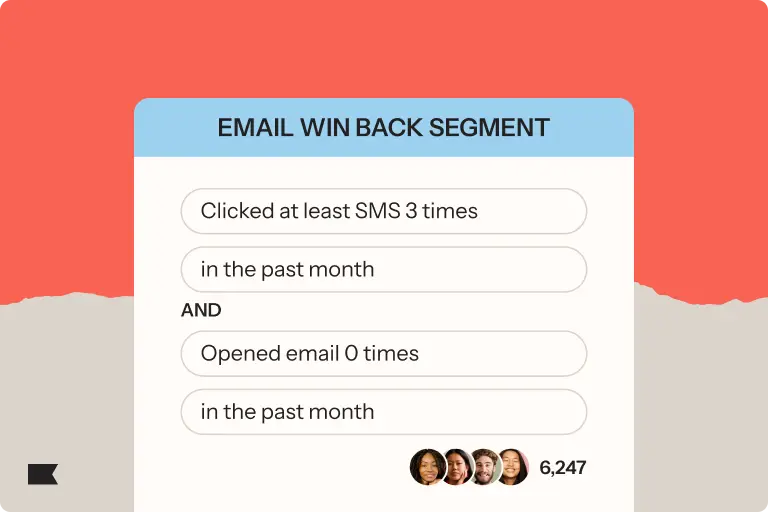Rethink email marketing metrics: 8 key metrics to track and optimize in 2025

The way successful brands measure and optimize their email marketing metrics has changed a lot in the last few years.
Between iOS 15, lower retail margins, and the recession affecting spending habits, your email and SMS channels need to work harder—and smarter—than they did before.
Alexa Kilroy, head of brand at Triple Whale, has noticed the shift. “Consumers are doing less impulse buying, so DTC brands are seeing longer sales cycles,” she says. “Rather than churning and burning through acquiring customers, they’re more focused on retention metrics—and they’re investing in ongoing post-purchase communication.”
Rather than churning and burning through acquiring customers, DTC brands are more focused on retention metrics.
Whether you’re actively growing your list or refining segments, the following 8 email metrics are the key to confident digital marketing decisions.
1. Click rate
Click rate is the rate of how many people clicked a link within your email out of the total number of emails that were delivered. Considered a 3-in-1 metric because deliverability, opens, and clicks all impact it, it’s a “true indicator of customer engagement,” says Erin Aguilar, senior customer success manager at Klaviyo.
Click rate is a true indicator of customer engagement.
How to calculate click rate
To calculate click rate, divide the total number of unique clicks by total deliveries.
Use total unique clicks (which doesn’t count the number of times a subscriber clicks the same link in your email) rather than total cumulative clicks (which does count repeated clicks)—it’s a more accurate measure of true audience engagement.
8 ways to improve your click rate
Click rate is a topic worth educating yourself on, but here are 8 ways to head in the right direction:
- Practice healthy email list habits by segmenting
- Focus on your subject line
- Create a content test
- Optimize your emails for mobile
- Be strategic about call-to-action (CTA) placement
- Instill a sense of urgency
- Choose your email send time wisely
- Create personalized, automated email flows
2. “Active on site”
Whereas click rates are a good place to start measuring engagement, the “active on site” metric measures product interest and buying intent—which is of course the desired action—with more granularity.
When you measure website activity, you see what happens after someone clicks on your email—specifically:
- How much time they spend on your website
- Which product pages or landing pages they browse
- What they leave in their carts
How to use “active on site”
Use website activity data to personalize your email marketing strategy. “Active on site” information tells you where people are spending the most time on your website, so you can segment email recipients based on their interests and engagement level.
How to improve your “active on site” rate
- Segmenting your lists
- Creating interactive content like quizzes, polls, and games (which not only helps you keep users on your website for longer, but can collect valuable information)
- Improving your website experience. A few ways to do this:
- Suggest similar products on description pages
- Offer several product category selections, including bestsellers
- Meet accessibility standards
- Invest in detailed product description pages
- Make sure your pages load quickly, especially on mobile devices.
3. Conversion rate
Email conversion rate measures the percentage of recipients who took action after they clicked on an email. The action you’ll likely measure most diligently is the purchase of a product—but this can vary business to business.
How to calculate conversion rate
To calculate email conversion rate, divide total conversions by total email deliveries and multiply by 100.
How to improve conversion rate
To improve conversion rate, apply similar principles to improving website activity—except here, you’ll need to also improve the online purchase experience.
Here are some ways to do this:
- Minimize the number of steps to purchase.
- Provide multiple payment options.
- Provide detailed product information, including specifications, customer reviews, user-generated content, and high-quality product images.
- Implement live chat support.
- Optimize for mobile.
This is also another opportunity to “segment people as much as you can,” says Rose-Marie Clément, content strategist and email marketing specialist at Novatize. “Make the email content mean something to them. Make them see themselves in your content,” she says.
Segment people as much as you can. Make the email content mean something to them. Make them see themselves in your content.
4. Revenue per recipient
Revenue per recipient (RPR) is how you answer the question: How much money is one email recipient worth?
RPR is a straightforward metric for understanding how much money every email recipient is bringing in. RPR is also great for understanding the efficiency of your email marketing strategy, and whether or not you’re segmenting your list properly.
How to calculate revenue per recipient
To calculate RPR, divide the total amount of revenue your email generated by total email deliveries.
How to improve revenue per recipient
“The best way to optimize email revenue per recipient is by refining your segmentation strategy,” says Randy McHugh, founder of Stimulate Agency.
The best way to optimize email revenue per recipient is by refining your segmentation strategy.
“Sending subscribers irrelevant messages and offers results in lower engagement and a diminished revenue per recipient. Instead, utilize zero and first-party data you can collect via Klaviyo to craft personalized messages and offers for distinct segments. When done correctly, tailoring your messages to specific segments will increase engagement and lift your revenue per recipient,” McHugh advises.
Use zero- and first-party data to segment your lists based on:
- People who have made a purchase
- VIP customers who spend a lot
- Holiday shoppers
- Website browsers
- Cart abandoners
- Product interest
- Event attendees
- Discount shoppers
Segmentation will also help you set expectations for “normal” RPR within each segment. Your discount shoppers, for example, may yield a lower RPR to begin with, but they may yield more over time as they become loyal to your brand.
5. Deliverability rates
Your deliverability rate is the percentage of emails that makes it to your recipients’ inboxes.
As much as we’d like to believe every person on our list receives the emails we send, it’s just not true. Some emails bounce back. Some end up in spam.
If you’re seeing low deliverability rates, it’s likely in the form of email bounces.
Email bounces come in two flavors:
- Hard bounces: emails that can’t be delivered because the email address is fake or spam
- Soft bounces: emails that can’t be delivered for a temporary reason, such as a full inbox
How to calculate email deliverability
To calculate email deliverability rate, divide the number of emails delivered to inboxes by the total number of emails sent and multiply by 100.
How to improve email deliverability
The best way to improve deliverability and lower your email bounce rate is to send good emails to people who asked to receive them. Here are 5 specific ways to make sure you’re doing that:
- Clean your lists regularly
- Develop a sunset flow
- Use double opt-in
- Make it easy to unsubscribe
- Create personalized content
6. Unsubscribe rate
Your unsubscribe rate is the percentage of people who receive your email and then unsubscribe from your list.
How to calculate unsubscribe rate
To calculate unsubscribe rate, divide the number of people who unsubscribe by the total number of emails delivered and multiply by 100.
How to improve unsubscribe rate
To improve unsubscribe rates, review how to improve CTR and email deliverability. The same principles apply.
7. List growth rate
List growth rate tracks the rate at which you’re acquiring new subscribers to your list. A tricky metric that risks falling into vanity territory, list growth rate is only meaningful when high engagement comes along for the ride.
How to calculate list growth rate
To calculate list growth rate, subtract the number of unsubscribes from the number of new subscribers within a given time period. Divide that number by the total number of recipients on that list and multiply by 100.
How to improve list growth rate
Now that we’ve successfully downplayed the importance of list growth rate, here’s where we acknowledge that new subscriber acquisition is still important. If you want to increase list growth rate, here are a few strategies to try:
- Pair a sign-up form with a discount
- Partner with another brand
- Use referrals
8. Return on investment (ROI)
Your return on investment (ROI) is the financial return from your email program as compared to the money you’ve spent. To calculate the cost of your email marketing program, you’ll need to factor in:
- Marketing and email automation platform cost
- Human resources: writers, designers, data analytics specialists, marketing operations specialists, etc.
- Third-party vendors: list cleaning, strategy, A/B testing, delivery, etc.
- Ads to encourage sign-ups
How to calculate return on investment
To calculate ROI, subtract total costs from revenue attributed to your email channel. Then divide that number by cost and multiply by 100.
Through list segmentation, a focus on personalized, relevant content, and human empathy, you can start to improve ROI by simply…giving the people what they want.
Conclusion
Now that you know what to track, it’s time to decide on your reporting cadence. The most important aspect of reporting on email performance metrics is picking a consistent cadence, whether it is bi-weekly, monthly, or quarterly.
Longer reporting cadences give an overall picture of the health of your email list and customer loyalty, while shorter reporting cadences give insight into specific campaign performance and can be useful for identifying areas of improvement.

Related content

Discover the best email marketing platform for ecommerce in 2026. Compare top tools for data, automation, personalization, and deliverability.

Learn how to use Klaviyo SMS, segmentation, and hybrid flows to re-engage lapsed email subscribers, boost deliverability, and drive higher retention.

Boost D2C email revenue from 12% to 30% with the Klaviyo playbook: high-converting pop-ups, a 5-email welcome series, smart filters, and optimized abandonment flows.